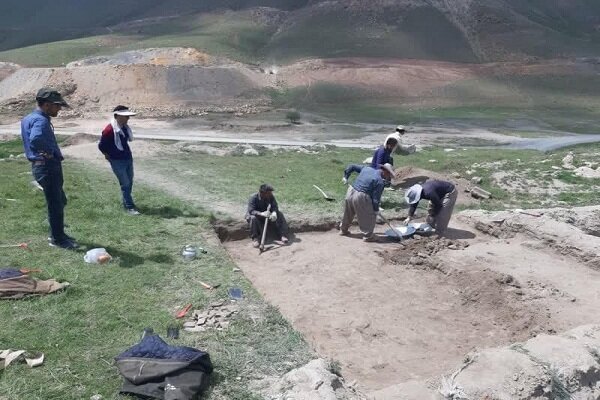Archaeologists hail find of 7,000-year-old relics in northwest Iran

TEHRAN - A team of Iranian archaeologists has found arrays of relics estimated to date some 7,000 years during its recent excavations conducted in Oshnavieh, northwest Iran.
The relics were found near Sufian Hill, which dates 7,000 years and belongs to Dalma culture, Mehr quoted archaeologist Mahnaz Sharifi as saying on Friday.
“In this research, we tried to get a clearer picture of the Old Copper and Stone Ages and particularly the Dalma culture in northwest Iran,” the archaeologist said.
Dalma is the name given to a prehistorical culture whose widespread ceramic remains were excavated in central and northern valleys of the Zagros Mountains in north-western Iran.
“The preliminary results of the excavation show the remains of solid and permanent architecture used for permanent settlement, and this issue is significant in this respect because, before this, most of the sites of the 5th millennium BC had poor architecture,” Sharifi explained.
Inside the architectural space, terracotta pots were found, which were made in the basket method, she said.
The team has found an adobe [architectural] platform in this excavation, she said. “Another very important point in this excavation is the discovery of a structure (probably a furnace or a thermal structure), which is also unique in its kind and has not been reported in the same sites so far.”
During these archaeological excavations, more than three and a half meters of [soil] accumulation related to the 5th millennium BC was identified, which adds to our knowledge of human civilization in that era, the archaeologist said.
A heaven for archaeologists
Oshnavieh county, which is surrounded by towering mountains, lies on a thick layer cake of civilizations that emerged and disappeared over millennia.
Situated in West Azarbaijan province, Oshnavieh is home to archaeological sites and hills, tomb chambers and bas-relief carvings belonging to the Kingdom of Urartu (860 BC– 590 BC). Moreover, it boasts some 100 sites registered on the national cultural heritage list.
The main reason why Oshnavieh is called an archaeologist’s paradise is that it was once a prosperous settlement for the Urartu kingdom, whose entombed relics still draw the attention of archaeologists and even illegal excavators to the region.
Over the past couple of years, Oshnavieh and its surrounding areas have witnessed a series of unauthorized, unprecedented drillings and excavations committed by unauthorized diggers and antique dealers, and smugglers.
The Urartu kingdom rose to power in the mid-9th century BC, but it went into a gradual decline and was eventually conquered by the Iranian Medes in the early 6th century BC. The Urartians were succeeded in the area in the 6th century BC by the Armenians.
Urartu is an ancient country of southwest Asia centered in the mountainous region southeast of the Black Sea and southwest of the Caspian Sea. Today the region is divided among Armenia, eastern Turkey, and northwestern Iran. As mentioned in Assyrian sources from the early 13th century BC, Urartu enjoyed considerable political power in the Middle East in the 9th and 8th centuries BC.
According to Encyclopedia Iranica, the territory of the ancient kingdom of Urartu extended over the modern frontiers of Turkey, Iran, Iraq, and the Republic of Armenia. Its center was the Armenian highland between Lake Van, Lake Urmia, and Lake Sevan.
Urartian archeological finds in modern Iran include castles, settlements, water channels, other water constructions, rock chambers, rock graves, stelae, rock inscriptions and building inscriptions.
Most impressive are the Urartian architectural remains, with their different building forms and ground plans, mainly castles and larger fortresses. They range in size from small, mostly rectangular castles or road stations to the extended fortification systems of large settlements.
Urartian pottery is mainly earthenware and, to a lesser extent, red polished ceramic, so-called palace-ware, since it is found only in the larger, central Urartian sites. Urartian pottery is mostly monochrome ware made by the potter’s wheel.
Cuneiform inscriptions have been found on clay tablets, cylinder seals, and bullae; there are inscriptions on building stones, as at Bastam, and rock inscriptions, and others on stelae and clay vessels.
The Urartian rock chambers influenced the Achaemenid rock graves in layout and stonecutter techniques. The monumental scale of the Urartian rock cuttings and surface preparation for cuneiform inscriptions prepared the way for the Achaemenid monumental inscriptions, in particular, that of Darius at Bisotun.
Archaeological excavations suggest that agriculture entered into a new stage owing to the practice of irrigation by Urartus in northwest Iran. Thanks to the water management exercise, the Oshnavieh Plain was so productive for a long time. The water supply system realized by the Urartu in the first half of the first millennium BC has been so remarkable that the contemporaneous people imitated them.
AFM
